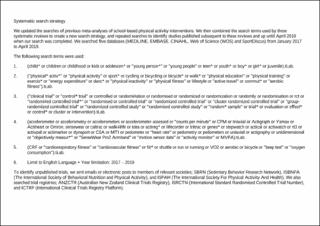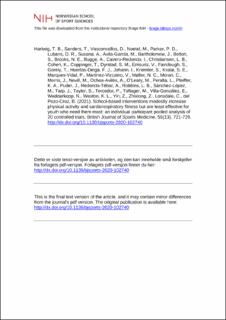| dc.contributor.author | Hartwig, Timothy Bryan | |
| dc.contributor.author | Sanders, Taren | |
| dc.contributor.author | Vasconcellos, Diego | |
| dc.contributor.author | Noetel, Michael | |
| dc.contributor.author | Parker, Philip D. | |
| dc.contributor.author | Lubans, David Revalds | |
| dc.contributor.author | Susana, Andrade | |
| dc.contributor.author | Ávila-García, Manuel | |
| dc.contributor.author | Bartholomew, John | |
| dc.contributor.author | Belton, Sarahjane | |
| dc.contributor.author | Brooks, Naomi E. | |
| dc.contributor.author | Bugge, Anna | |
| dc.contributor.author | Cavero-Redondo, Ivan | |
| dc.contributor.author | Christiansen, Lars Breum | |
| dc.contributor.author | Cohen, Kristen | |
| dc.contributor.author | Coppinger, Tara | |
| dc.contributor.author | Dyrstad, Sindre Mikal | |
| dc.contributor.author | Errisuriz, Vanessa | |
| dc.contributor.author | Fairclough, Stuart | |
| dc.contributor.author | Gorely, Trish | |
| dc.contributor.author | Huertas-Delga, Francisco Javier | |
| dc.contributor.author | Johann, Issartel | |
| dc.contributor.author | Kriemler, Susi | |
| dc.contributor.author | Kvalø, Silje Eikanger | |
| dc.contributor.author | Marques-Vidal, Pedro | |
| dc.contributor.author | Martinez-Vizcaino, Vicente | |
| dc.contributor.author | Møller, Niels Christian | |
| dc.contributor.author | Moran, Colin | |
| dc.contributor.author | Morris, John | |
| dc.contributor.author | Nevill, Mary | |
| dc.contributor.author | Ochoa-Avilés, Angélica | |
| dc.contributor.author | O'Leary, Mai | |
| dc.contributor.author | Peralta, Louisa | |
| dc.contributor.author | Pfeiffer, Karin Allor | |
| dc.contributor.author | Puder, Jardena | |
| dc.contributor.author | Redondo-Tébar, Andrés | |
| dc.contributor.author | Robbins, Lorraine B. | |
| dc.contributor.author | Sánchez-López, Mairena | |
| dc.contributor.author | Tarp, Jakob | |
| dc.contributor.author | Taylor, Sarah | |
| dc.contributor.author | Tercedor, Pablo | |
| dc.contributor.author | Toftager, Mette | |
| dc.contributor.author | Villa-González, Emilio | |
| dc.contributor.author | Wedderkopp, Niels | |
| dc.contributor.author | Weston, Kathryn Louise | |
| dc.contributor.author | Yin, Zenong | |
| dc.contributor.author | Zhixiong, Zhou | |
| dc.contributor.author | Lonsdale, Chris | |
| dc.contributor.author | del Pozo-Cruz, Borja | |
| dc.date.accessioned | 2021-11-23T08:23:28Z | |
| dc.date.available | 2021-11-23T08:23:28Z | |
| dc.date.created | 2021-01-25T13:40:24Z | |
| dc.date.issued | 2021 | |
| dc.identifier.citation | British Journal of Sports Medicine. 2021, 55(13), 721-729. | en_US |
| dc.identifier.issn | 0306-3674 | |
| dc.identifier.uri | https://hdl.handle.net/11250/2830872 | |
| dc.description | Dette er siste tekst-versjon av artikkelen, og den kan inneholde små forskjeller fra forlagets pdf-versjon. Forlagets pdf-versjon finner du her: http://dx.doi.org/10.1136/bjsports-2020-102740 / This is the final text version of the article, and it may contain minor differences from the journal's pdf version. The original publication is available here: http://dx.doi.org/10.1136/bjsports-2020-102740 | en_US |
| dc.description.abstract | Objectives: To determine if subpopulations of students benefit equally from school-based physical activity interventions in terms of cardiorespiratory fitness and physical activity. To examine if physical activity intensity mediates improvements in cardiorespiratory fitness.
Design: Pooled analysis of individual participant data from controlled trials that assessed the impact of school-based physical activity interventions on cardiorespiratory fitness and device-measured physical activity.
Participants: Data for 6621 children and adolescents aged 4-18 years from 20 trials were included.
Main outcome measures: Peak oxygen consumption (VO2Peak mL/kg/min) and minutes of moderate and vigorous physical activity.
Results: Interventions modestly improved students' cardiorespiratory fitness by 0.47 mL/kg/min (95% CI 0.33 to 0.61), but the effects were not distributed equally across subpopulations. Girls and older students benefited less than boys and younger students, respectively. Students with lower levels of initial fitness, and those with higher levels of baseline physical activity benefitted more than those who were initially fitter and less active, respectively. Interventions had a modest positive effect on physical activity with approximately one additional minute per day of both moderate and vigorous physical activity. Changes in vigorous, but not moderate intensity, physical activity explained a small amount (~5%) of the intervention effect on cardiorespiratory fitness.
Conclusions: Future interventions should include targeted strategies to address the needs of girls and older students. Interventions may also be improved by promoting more vigorous intensity physical activity. Interventions could mitigate declining youth cardiorespiratory fitness, increase physical activity and promote cardiovascular health if they can be delivered equitably and their effects sustained at the population level. | en_US |
| dc.language.iso | eng | en_US |
| dc.subject | cardiorespiratory fitness | en_US |
| dc.subject | individual participant data (IPD) | en_US |
| dc.subject | moderate to vigorous physical activity | en_US |
| dc.subject | peak oxygen consumption | en_US |
| dc.subject | school-based physical activity intervention | en_US |
| dc.subject | youth | en_US |
| dc.title | School-based interventions modestly increase physical activity and cardiorespiratory fitness but are least effective for youth who need them most: an individual participant pooled analysis of 20 controlled trials | en_US |
| dc.type | Peer reviewed | en_US |
| dc.type | Journal article | en_US |
| dc.description.version | acceptedVersion | en_US |
| dc.source.pagenumber | 721-729 | en_US |
| dc.source.volume | 55 | en_US |
| dc.source.journal | British Journal of Sports Medicine | en_US |
| dc.source.issue | 13 | en_US |
| dc.identifier.doi | 10.1136/bjsports-2020-102740 | |
| dc.identifier.cristin | 1878473 | |
| dc.description.localcode | Institutt for idrettsmedisinske fag / Department of Sports Medicine | en_US |
| cristin.ispublished | true | |
| cristin.fulltext | postprint | |
| cristin.fulltext | postprint | |
| cristin.qualitycode | 2 | |

